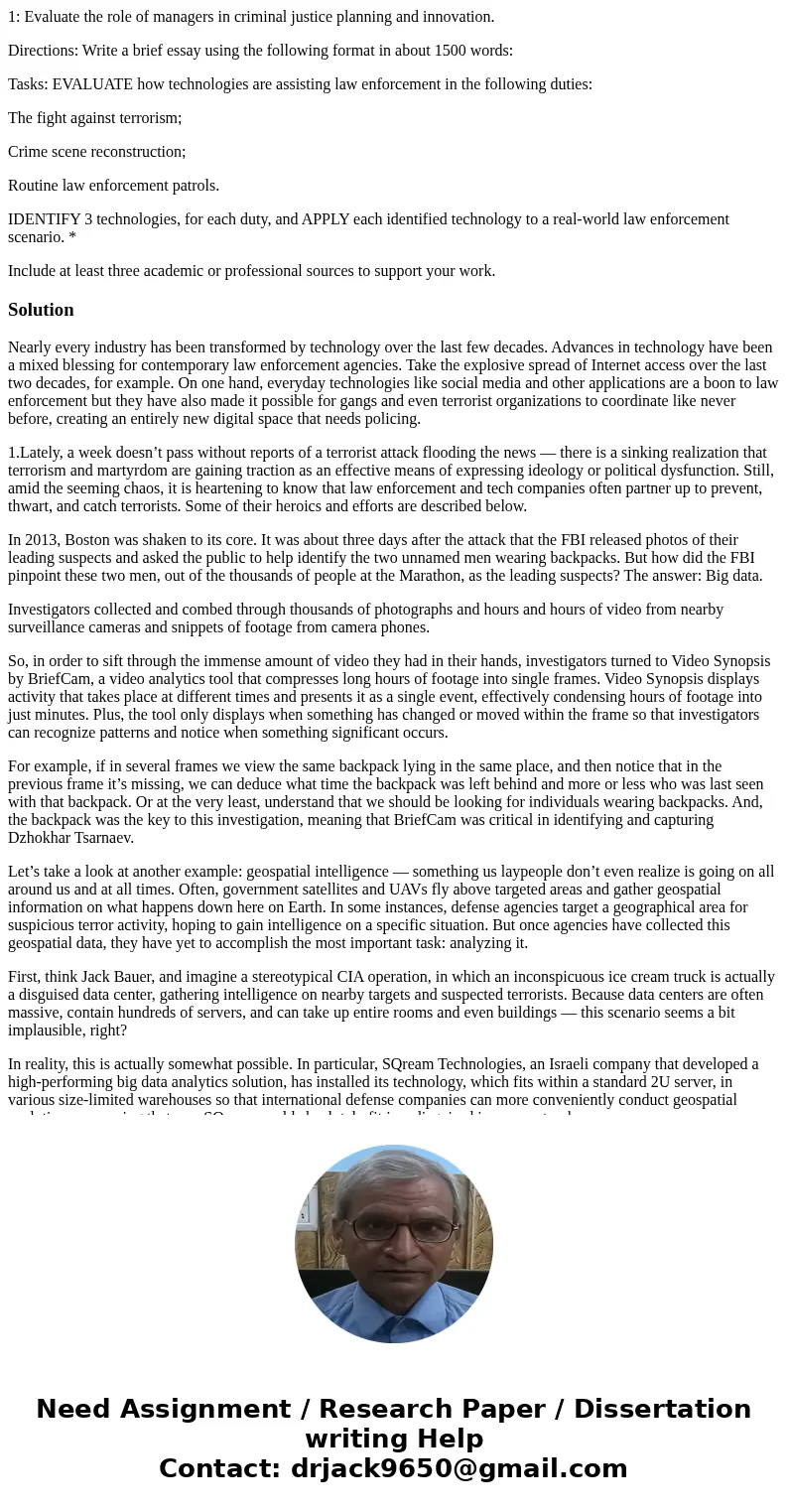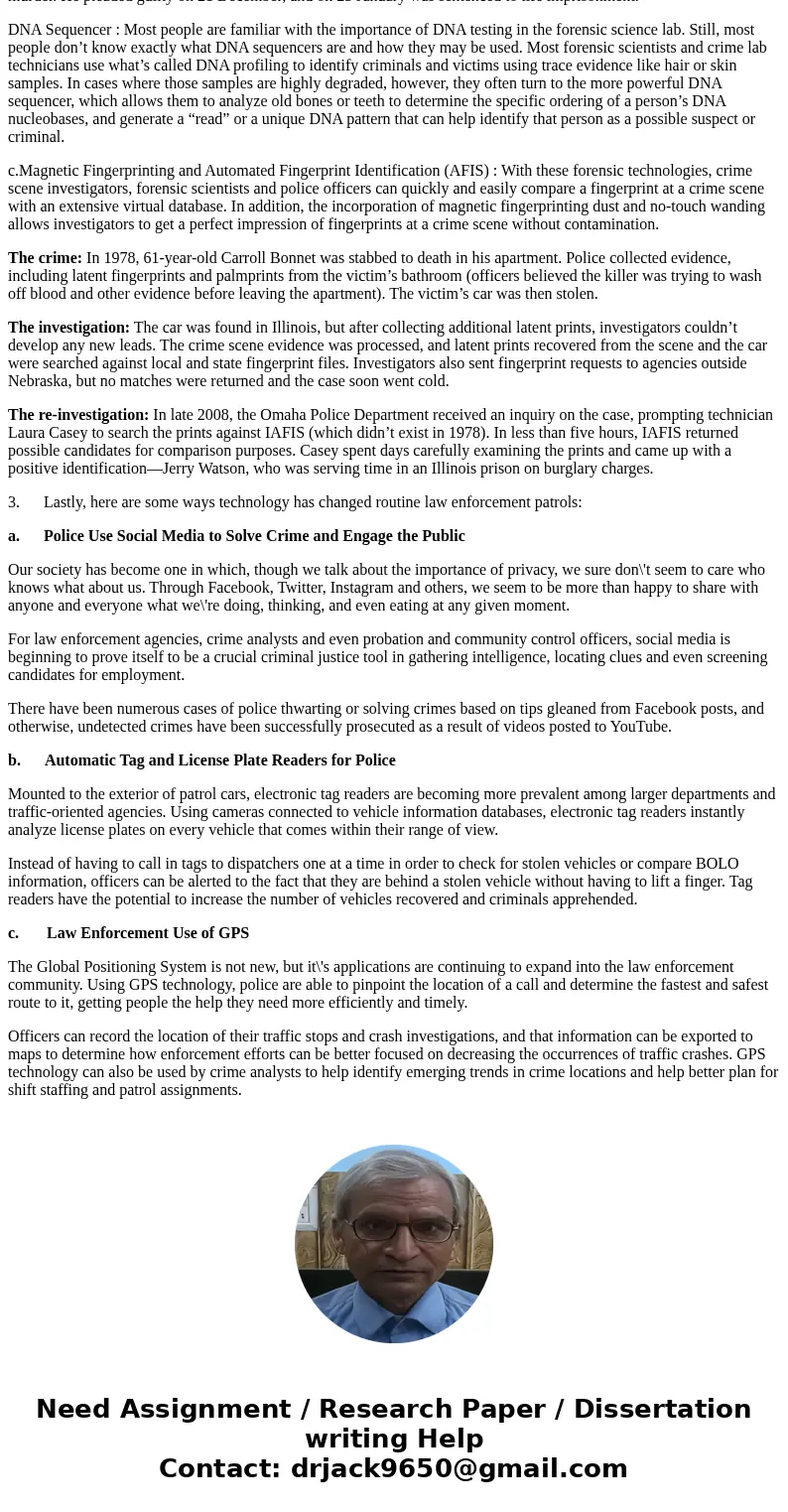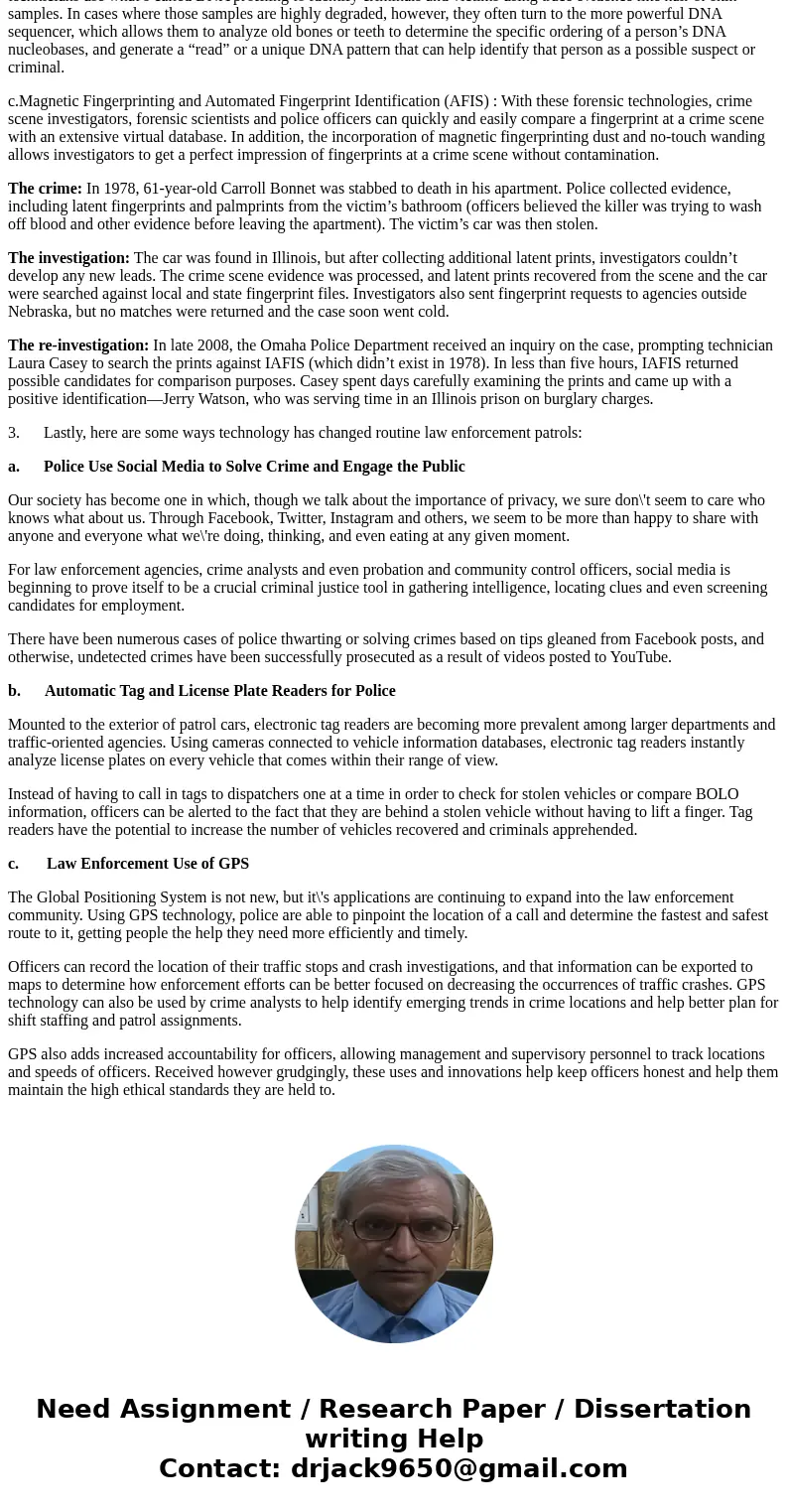1 Evaluate the role of managers in criminal justice planning
1: Evaluate the role of managers in criminal justice planning and innovation.
Directions: Write a brief essay using the following format in about 1500 words:
Tasks: EVALUATE how technologies are assisting law enforcement in the following duties:
The fight against terrorism;
Crime scene reconstruction;
Routine law enforcement patrols.
IDENTIFY 3 technologies, for each duty, and APPLY each identified technology to a real-world law enforcement scenario. *
Include at least three academic or professional sources to support your work.
Solution
Nearly every industry has been transformed by technology over the last few decades. Advances in technology have been a mixed blessing for contemporary law enforcement agencies. Take the explosive spread of Internet access over the last two decades, for example. On one hand, everyday technologies like social media and other applications are a boon to law enforcement but they have also made it possible for gangs and even terrorist organizations to coordinate like never before, creating an entirely new digital space that needs policing.
1.Lately, a week doesn’t pass without reports of a terrorist attack flooding the news — there is a sinking realization that terrorism and martyrdom are gaining traction as an effective means of expressing ideology or political dysfunction. Still, amid the seeming chaos, it is heartening to know that law enforcement and tech companies often partner up to prevent, thwart, and catch terrorists. Some of their heroics and efforts are described below.
In 2013, Boston was shaken to its core. It was about three days after the attack that the FBI released photos of their leading suspects and asked the public to help identify the two unnamed men wearing backpacks. But how did the FBI pinpoint these two men, out of the thousands of people at the Marathon, as the leading suspects? The answer: Big data.
Investigators collected and combed through thousands of photographs and hours and hours of video from nearby surveillance cameras and snippets of footage from camera phones.
So, in order to sift through the immense amount of video they had in their hands, investigators turned to Video Synopsis by BriefCam, a video analytics tool that compresses long hours of footage into single frames. Video Synopsis displays activity that takes place at different times and presents it as a single event, effectively condensing hours of footage into just minutes. Plus, the tool only displays when something has changed or moved within the frame so that investigators can recognize patterns and notice when something significant occurs.
For example, if in several frames we view the same backpack lying in the same place, and then notice that in the previous frame it’s missing, we can deduce what time the backpack was left behind and more or less who was last seen with that backpack. Or at the very least, understand that we should be looking for individuals wearing backpacks. And, the backpack was the key to this investigation, meaning that BriefCam was critical in identifying and capturing Dzhokhar Tsarnaev.
Let’s take a look at another example: geospatial intelligence — something us laypeople don’t even realize is going on all around us and at all times. Often, government satellites and UAVs fly above targeted areas and gather geospatial information on what happens down here on Earth. In some instances, defense agencies target a geographical area for suspicious terror activity, hoping to gain intelligence on a specific situation. But once agencies have collected this geospatial data, they have yet to accomplish the most important task: analyzing it.
First, think Jack Bauer, and imagine a stereotypical CIA operation, in which an inconspicuous ice cream truck is actually a disguised data center, gathering intelligence on nearby targets and suspected terrorists. Because data centers are often massive, contain hundreds of servers, and can take up entire rooms and even buildings — this scenario seems a bit implausible, right?
In reality, this is actually somewhat possible. In particular, SQream Technologies, an Israeli company that developed a high-performing big data analytics solution, has installed its technology, which fits within a standard 2U server, in various size-limited warehouses so that international defense companies can more conveniently conduct geospatial analytics — meaning that yes, SQream could absolutely fit in a disguised ice cream truck.
In authoritarian countries where central governments are weak, terrorist organizations like Islamic State and Al Qaeda hold great power. Often, these organizations seize the government and enact harsh censorship laws, hoping their citizens will acquiesce. In these locations, the safety of everyday civilians and activists wishing to speak out against oppression are at risk — it’s common for authoritarian regimes to jail citizens they deem traitors, when really, they’re typical citizens simply blogging about harsh experiences.
It’s important then, that citizens living in oppressive regimes are able to conceal their identities online. Often, they use Virtual Private Networks (VPN) to do so. A VPN is a group of networks that overlay a public network. It secures your computer’s internet connection, guaranteeing that the data you send and receive is encrypted and secured from third-parties. This way, activists are free to blog about topics their government might dislike.
In December 2014, SaferVPN began their “Unblock The Web” campaign, realizing that their VPN service could greatly benefit activists and dissidents living in closed societies.
a. 3 D laser scanning
One of the newer technologies for mapping crime scenes is the 3-D laser scanner. The original technology was developed in the 1960s. By the mid-1990s advances in technology allowed scanners to become portable. In the last 15 years the cost of a scanner has decreased, and police agencies can now reasonably afford one.
A 3-D scanner is like mating a total station (surveying instrument) to a digital camera and pumping it full of steroids. Unlike the total station, a 3-D scanner does not need targets. The laser can reflect off the majority of surfaces to produce measurements on everything within its line of sight.
The laser takes a measurement, moves a millimeter and then records the next measurement. It repeats this, measuring out tens of thousands of points every second. After about six minutes a scan is completed, and the device can be set up for the next scan. The device also has the ability to record digital photos of the scene.
Due to line-of-sight issues, it might take multiple scans to fully cover a room. However, the time to move a 3-D scanner is quick compared to a total station.
COURT CASE SCENARIO:
In a Wisconsin court case, a woman was found dead in her bed with a gunshot wound to her temple. A second bullet hole was on the wall just to the left of her.
The police scanned the room with a 3 D scanner
The victim’s husband was the suspect, and it took a day to locate him at an address out of state. There were a few variations to his story, but all of them involved a malfunction with his firearm leading to an unwanted discharge. Tracking back the possible trajectories for the two rounds did not line up. Some lateral movement took place.
A two-dimensional overhead sketch of the scene did not show the scene as accurately as the 3-D model. As the investigating officer testified, the jury comprehended the scene of the crime easily.
It was never established why he fired two shots. The best theory was that his first shot missed and thus he moved to fire the second shot. The jury seemed to agree. They found him guilty of first-degree intentional homicide after only a couple of hours deliberating.
The defense had used a strategy of trying to confuse the jury. They put multiple experts on the stand to talk about firearm malfunctions and ballistics. These technical confusion tactics did nothing to undermine the virtual environment the police had created using the 3 D scanner.
b. The rise of DNA analysis in crime solving
In June 2008, a 19-year-old man from Nottingham was arrested for careless and inconsiderate driving. His DNA profile was uploaded to the database, it was flagged as a close but not perfect match to the profile of the probable killer of Colette Aram.
Aram, a 16-year-old trainee hairdresser from Keyworth in Nottinghamshire, was abducted, raped and strangled on 30 October 1983 – five years before the careless driver was born. The police had a few circumstantial leads to go on and the careless driver\'s father, Paul Hutchinson, a 51-year-old newspaper delivery agent, was charged with Colette Aram\'s murder. He pleaded guilty on 21 December, and on 25 January was sentenced to life imprisonment.
DNA Sequencer : Most people are familiar with the importance of DNA testing in the forensic science lab. Still, most people don’t know exactly what DNA sequencers are and how they may be used. Most forensic scientists and crime lab technicians use what’s called DNA profiling to identify criminals and victims using trace evidence like hair or skin samples. In cases where those samples are highly degraded, however, they often turn to the more powerful DNA sequencer, which allows them to analyze old bones or teeth to determine the specific ordering of a person’s DNA nucleobases, and generate a “read” or a unique DNA pattern that can help identify that person as a possible suspect or criminal.
c.Magnetic Fingerprinting and Automated Fingerprint Identification (AFIS) : With these forensic technologies, crime scene investigators, forensic scientists and police officers can quickly and easily compare a fingerprint at a crime scene with an extensive virtual database. In addition, the incorporation of magnetic fingerprinting dust and no-touch wanding allows investigators to get a perfect impression of fingerprints at a crime scene without contamination.
The crime: In 1978, 61-year-old Carroll Bonnet was stabbed to death in his apartment. Police collected evidence, including latent fingerprints and palmprints from the victim’s bathroom (officers believed the killer was trying to wash off blood and other evidence before leaving the apartment). The victim’s car was then stolen.
The investigation: The car was found in Illinois, but after collecting additional latent prints, investigators couldn’t develop any new leads. The crime scene evidence was processed, and latent prints recovered from the scene and the car were searched against local and state fingerprint files. Investigators also sent fingerprint requests to agencies outside Nebraska, but no matches were returned and the case soon went cold.
The re-investigation: In late 2008, the Omaha Police Department received an inquiry on the case, prompting technician Laura Casey to search the prints against IAFIS (which didn’t exist in 1978). In less than five hours, IAFIS returned possible candidates for comparison purposes. Casey spent days carefully examining the prints and came up with a positive identification—Jerry Watson, who was serving time in an Illinois prison on burglary charges.
3. Lastly, here are some ways technology has changed routine law enforcement patrols:
a. Police Use Social Media to Solve Crime and Engage the Public
Our society has become one in which, though we talk about the importance of privacy, we sure don\'t seem to care who knows what about us. Through Facebook, Twitter, Instagram and others, we seem to be more than happy to share with anyone and everyone what we\'re doing, thinking, and even eating at any given moment.
For law enforcement agencies, crime analysts and even probation and community control officers, social media is beginning to prove itself to be a crucial criminal justice tool in gathering intelligence, locating clues and even screening candidates for employment.
There have been numerous cases of police thwarting or solving crimes based on tips gleaned from Facebook posts, and otherwise, undetected crimes have been successfully prosecuted as a result of videos posted to YouTube.
b. Automatic Tag and License Plate Readers for Police
Mounted to the exterior of patrol cars, electronic tag readers are becoming more prevalent among larger departments and traffic-oriented agencies. Using cameras connected to vehicle information databases, electronic tag readers instantly analyze license plates on every vehicle that comes within their range of view.
Instead of having to call in tags to dispatchers one at a time in order to check for stolen vehicles or compare BOLO information, officers can be alerted to the fact that they are behind a stolen vehicle without having to lift a finger. Tag readers have the potential to increase the number of vehicles recovered and criminals apprehended.
c. Law Enforcement Use of GPS
The Global Positioning System is not new, but it\'s applications are continuing to expand into the law enforcement community. Using GPS technology, police are able to pinpoint the location of a call and determine the fastest and safest route to it, getting people the help they need more efficiently and timely.
Officers can record the location of their traffic stops and crash investigations, and that information can be exported to maps to determine how enforcement efforts can be better focused on decreasing the occurrences of traffic crashes. GPS technology can also be used by crime analysts to help identify emerging trends in crime locations and help better plan for shift staffing and patrol assignments.
GPS also adds increased accountability for officers, allowing management and supervisory personnel to track locations and speeds of officers. Received however grudgingly, these uses and innovations help keep officers honest and help them maintain the high ethical standards they are held to.




 Homework Sourse
Homework Sourse